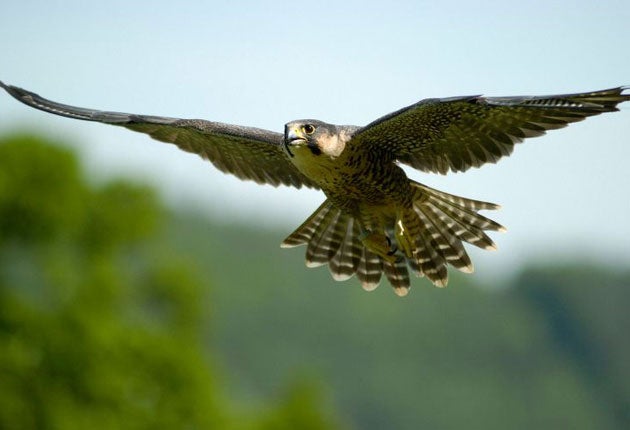Urban peregrines lay first egg of the year

Your support helps us to tell the story
From reproductive rights to climate change to Big Tech, The Independent is on the ground when the story is developing. Whether it's investigating the financials of Elon Musk's pro-Trump PAC or producing our latest documentary, 'The A Word', which shines a light on the American women fighting for reproductive rights, we know how important it is to parse out the facts from the messaging.
At such a critical moment in US history, we need reporters on the ground. Your donation allows us to keep sending journalists to speak to both sides of the story.
The Independent is trusted by Americans across the entire political spectrum. And unlike many other quality news outlets, we choose not to lock Americans out of our reporting and analysis with paywalls. We believe quality journalism should be available to everyone, paid for by those who can afford it.
Your support makes all the difference.Urban peregrine falcons are poised to capture the hearts of city dwellers once again this spring after a female laid the first city peregrine egg of 2009 in a Birmingham factory.
The fastest creatures on the planet are increasingly nesting on tall landmarks in Britain's metropolises, from power stations to cathedrals, and a nest webcam has captured the single egg of a nesting female on Fort Dunlop, the former Birmingham tyre factory now redeveloped as a retail centre. It can be viewed online from this morning.
Other likely nesting locations for peregrines, among the world's most striking birds of prey, include cathedrals in Lincoln, Derby and Chichester, Cardiff clock tower, and Manchester's Arndale shopping centre, while in Greater London there are believed to be more than a dozen pairs within 20 miles of St Paul's. Nesting sites include Tate Modern, the Battersea Power Station and the Millennium Dome.
After a population crash in the 1960s caused by pesticides, which reduced their numbers to no more than 350 pairs throughout Britain, the birds have made a remarkable comeback to a present population of about 1,500 pairs. They have spread into towns and cities, helped by the abundant supply of a favourite food – wild pigeons.
They have also proved adaptable to urban habitats. Traditionally associated with mountain crags or lonely sea cliffs, the birds have found major structures to their liking, as to a peregrine, an office block or church spire offers the same benefits as a cliff: it is high and safe from danger, while the surrounding areas (pigeon-populated parks) offer ample prey.
Urban peregrines win admiration with a presence like no other. Choosing their prey at a distance, they go in for the kill, stooping (diving deeply) towards their targets at over 100mph, making them the fastest creatures on Earth. The impact at such speed means that prey is often killed instantly.
"People never fail to be wowed by the news that one of the fastest and most powerful hunters on the planet lives just above their heads," said Louise Pedersen, from the RSPB's West Midlands office. "We were so relieved and excited to see the egg when we checked the nestcam footage. To get views of them so close up via the camera really brings it all to life and gets even the most resolute urbanites excited about wildlife."
Join our commenting forum
Join thought-provoking conversations, follow other Independent readers and see their replies
Comments